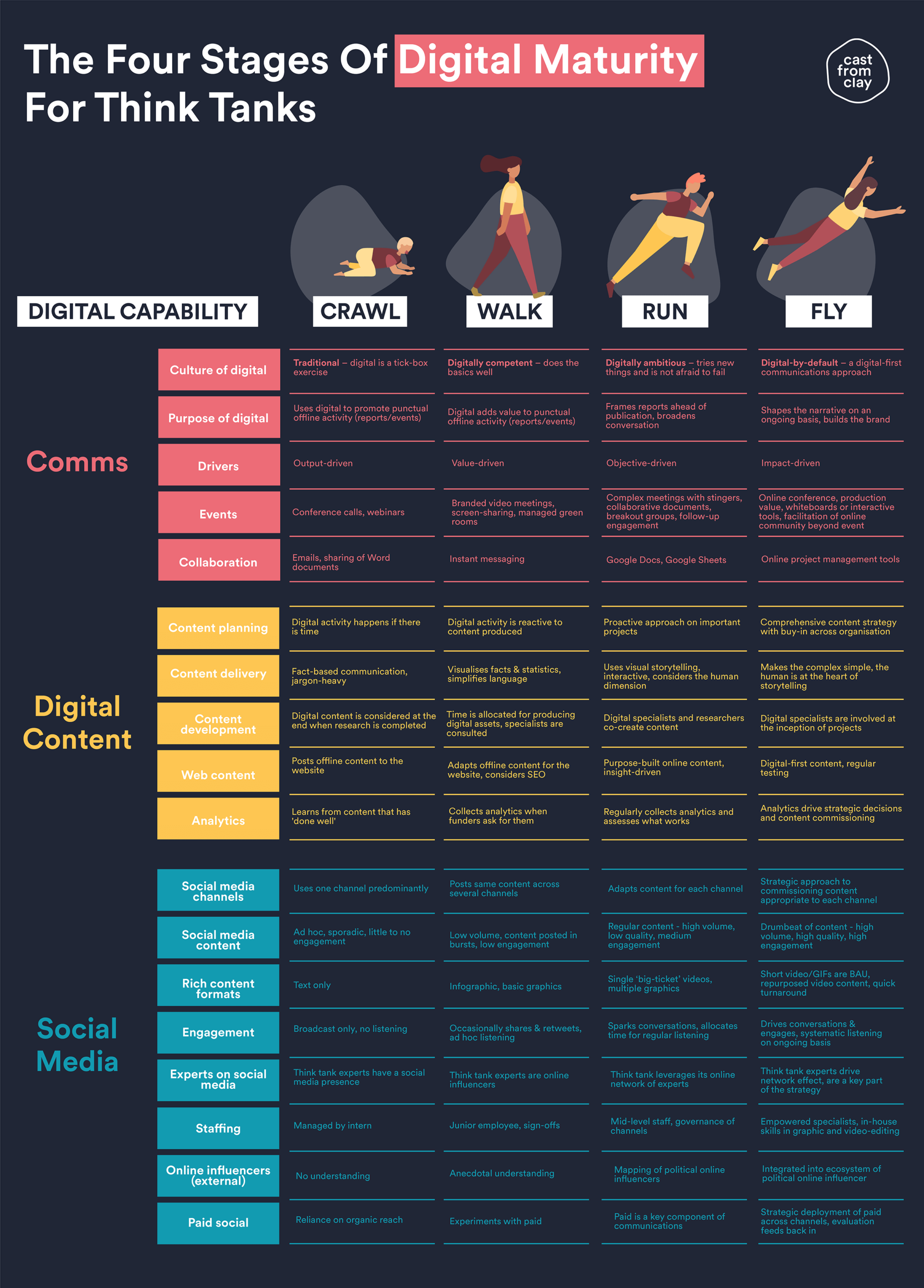Truth is, the think tank sector remains quite traditional in its majority. So it’s hard to point to a single organisation as being a digital pioneer – a ‘digital-first’ think tank.
We have, however, come across pockets of excellence. From the Heritage Foundation’s use of multi-media to shape the narrative, to Chatham House’s use of insight to inform content and strategy, via the OECD’s engagement with online influencers, or the ODI’s experimentation with alternatives to reports to get their messages across.
So we’ve taken the best of what we’ve come across, and turned it into a roadmap.
Our roadmap
We defined a number of areas in which progress could/needed to be made, based on what we have observed over the last few years. Some are simply executional – others are more attitudinal. (We’ve included the full list with definitions below.)
And we have mapped these criteria across a 4-stage model of digital maturity. This is not an exhaustive list – we look forward to hearing your thoughts about how we can improve this model, and will update this with good ideas as we go along.
We have organised the criteria into three categories: communications, digital content and social media. These categories are not mutually-exclusive. Social media obviously relies heavily on content, and these are all at the service of broader communications. However, it is useful to think about these separately.
How to use this model:
We don’t expect any one organisation to neatly fit into one of these stages or another. Rather, we expect most organisations to be advanced in some areas, and maybe not so advanced in others.
This should serve as a benchmark for organisations who are looking for where they can improve further. We are hoping to turn this model into a free interactive benchmarking tool. If you would like to know more, please get in touch.

Our criteria
Communications:
- Culture of digital: The mindset within the organisation which informs how digital is approached.
- Purpose of digital: The extent to which digital used as an end in itself, rather than an extension of offline activity.
- Drivers: The internal KPIs which inform whether digital activity is deemed a success or not.
- Events: The approach to delivering events in a virtual way.
- Collaboration: The means by which team members use digital to work together.
Digital content:
- Content planning: The planning of digital activity, in particular whether it is guided by strategic considerations or is it reactive.
- Content delivery: The extent to which content development is shaped by audiences’ needs and preferences.
- Content development: The nature of research teams’ engagement with digital experts, as executors or strategic partners.
- Web content: The approaches to web content – in particular whether it is genuinely digital content, or offline content hosted online.
- Analytics: The relationship to collecting content performance data, and using it to feed into decision-making.
Social media:
- Social media channels: The use of multiple platforms, and content which leverages what each platform is good at.
- Social media content: The balance between volume, regularity and quality of social media content.
- Rich content formats: The use of visual content like images, video, GIFs, and attitudes to how they are used.
- Engagement: The extent to which an organisation leverages and values the ‘social’ in social media, and listens to what others have to say.
- Experts on social media: The extent to which the organisation’s experts are integrated into the organisation’s social strategy.
- Staffing: The responsibility for social media channels – usually an indicator of how much the organisation values digital.
- Online influencers (external): The extent to which the organisation and its experts leverage the ecosystem of political online influencers.
- Paid social: The role of paid promotion, and its targeting capabilities, in getting the organisation’s messaging to its audiences.
With thanks to Andrew Marshall from the Atlantic Council, and Joseph Barnsley from the RSA for their input.
Image credit: Sean Benesh on Unsplash.





